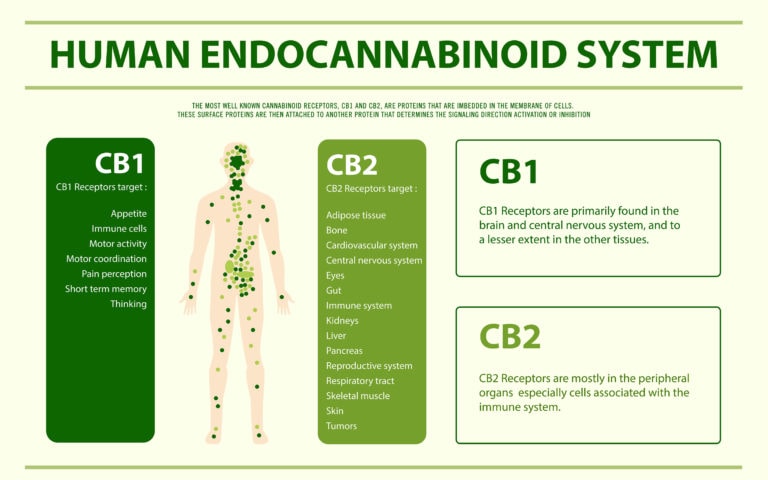
Why Testing CBD Is So Important
CBD Oil is everywhere these days, but that doesn’t necessarily mean all are at industry standard. Any brand can claim that their cannabis product is

If you’ve been spending time researching and looking into CBD products you’ll see that most websites and blogs will often mention The Endocannabinoid System (ECS) which can leave you wondering what is that all about?
Most of the medical marijuana is based on the study of cannabinoids. They are similar in structure to the neurotransmitters, which we call “endocannabinoids”, located in our peripheral and central nervous system. The network of these endocannabinoids in our bodies is called the endocannabinoid system.
Within our brain is something that’s known as the endocannabinoid system. It is a biological system composed of endocannabinoids. It naturally processes two distinct cannabinoid receptors (CB1 and CB2) throughout the entire nervous system.
This detailed system that exists inside our bodies was officially discovered in early 1990s by a team of researchers studying the effects of THC and is seen as potentially one of the most important parts of the CBD processing and the how and why CBD Oil works.
So we want you to learn all you can about understanding The Endocannabinoid System and CBD, the history, the basics, how it works, why it works, what the system does and the interaction it has with CBD.
When was it discovered?
In the late 1960s when scientists were studying and researching the effects that cannabis had on the body the ideas of this system called endocannabinoid began to reveal itself.
Through this research when they were studying the effects that phytocannabinoids (plant cannabinoids) had on the body of humans they started to discover that the human body was already constructing its very own unique set of cannabinoids known as endocannabinoids (internal cannabinoids).
According to Dr. John McPartland, a renowned cannabis expert and botanist, concluded that the endocannabinoid system began developing approx 600 million years ago. They discovered through this research that it’s very likely that not only do humans have this internal cannabinoid system but also all types of animals – from birds, mammals to reptiles and amphibians.
In the early 1990s researchers at Hebrew university confirmed that the neurotransmitter endocannabinoids exist.
So how does it work, the Endocannabinoid System?
The human body will always want to find homeostasis, a biological concept where all body systems are continuously working to stay regulated within optimum levels (equilibrium).
There is a set of functions that the body has to manage to maintain homeostasis, things like regulating body temperature, blood sugar levels, heart rate, blood pressure and pH levels.
The human body’s brilliant ability to balance itself out is what keeps us living at optimum.
Everything in the body needs to be balanced for us to be in homeostasis and the ECS plays a role in helping the body maintain its optimum conditions to do so. The Endocannabinoid Systems main goal is to always find homeostasis.
Our endocannabinoid system can very easily get out of balance by the modern lifestyle; too much stress, not looking after your health, diet, exercise. These all play a key role in how well the endocannabinoid system will function.
What does it do?
Alot!
The Endocannabinoid Systems plays an important role in assisting to regulate a huge range of the human body’s natural functioning; memory, mood, sleep, appetite, metabolism, perception of pain, inflammation, immune system responses…
There are 3 key components to The Endocannabinoid System that makes it function;
Did you know that your body already produces cannabinoids without you ever needing to consume a product like CBD or any other cannabis product.
Your body already houses endocannabinoids and creates 2 types of cannabinoids, which scientists have identified as anandamide and 2-arachidonoylglycerol
The human body produces these endocannabinoids as they are needed, to assist in regulation of internal functioning and are used to send messages in between cells.
So as cannabinoids are consumed and enter the body the cannabinoid receptors are designed to bind to cannabinoid receptors and match up like a lock and key.
The two major endocannabinoid receptors are located in the central nervous system (CB1) and the peripheral nervous system (CB2)
CB1 receptors are primarily located in the central nervous system (CNS), especially within the brain and spinal cord. They play a direct role in cognition, emotion, memory, motor control, appetite stimulation and the perception of pain.
CB2 receptors are primarily located in the peripheral nervous system (PNS) especially within the gastrointestinal and immune systems. These receptors regulate inflammation and other immune system responses.
These receptors allow cells to detect cannabinoids – both endocannabinoids and plant cannabinoids like CBD. Once a cannabinoid has been detected the receptors react by propelling the cell into action. Depending on the type of cell and the specific cannabinoid detected these responses can wildy vary.
The body eliminates it through the production of enzymes. This is important so that the cannabinoid neither triggers multiple cannabinoid receptors nor re-triggers the same receptor after the initial need has passed. If it were not broken down this way it could potentially limit the communication of cells or cause other negative side effects.
The two main known types of enzymes that work with theThe Endocannabinoid Systems (ECS):
So how does The Endocannabinoid System and CBD interact and work together?
Researchers are still unsure as to how precisely CBD interacts with the The Endocannabinoid System. However studies have shown unlike most cannabinoids bind to the major cannabinoid receptors in the body, the ‘plant cannabinoids’ or ‘phytocannabinoid’ CBD that we consume, do not actually bind to either of the CB1 and CB2 receptors.
Scientists currently believe that CBD (plant grown CBD) when consumed positively modifies our receptors ability to bind to cannabinoids rather than actually binding to the receptors itself.
There are more than 100 different plant cannabinoids and each has a slightly different interaction with the CB1 and CB2 receptors throughout the body.
Regardless of how the mechanisms function, CBD has been shown to have a wide range of therapeutic effects on both the mind and body. These effects vary depending on how much and the method of ingestion.
According to the World Health Organisation cannabinoids in the plant are not addictive, habit forming or psychoactive. The legalization of hemp has made it more possible for people to easily achieve a balanced state.
So ultimately by supporting your own body’s supply of cannabinoids with plant based compounds actually will support the The Endocannabinoid Systems role in maintaining homeostasis
Whilst we may be able to answer the question what is the The Endocannabinoid System (ECS) there still so much we don’t understand. It is a complex system but a vitality important system and further research needs to be done and as we discover more and more and as we do it allows us to become a healthier and happier world.

CBD Oil is everywhere these days, but that doesn’t necessarily mean all are at industry standard. Any brand can claim that their cannabis product is

CBD Oil industry is booming and it’s no wonder, more and more people are becoming more aware of the importance of their health and wellness

When anxiety comes knocking on your door, it can send your body into what feels like a frenzy. Monkey mind chatter, sweaty palms and a